The distinctiveness of the March international friendlies is that, more often than not, they represent the final uncompetitive fixtures for managers to experiment with new formations and tactics ahead of a proceeding international tournament. England’s routine victory over a disappointing Ivory Coast side on Tuesday evening was no exception to this testament, with the likes of Jude Bellingham and James Ward-Prowse playing significant and tactically unconventional roles that present manager Gareth Southgate a selection dilemma for this winter’s World Cup in Qatar.
A frustrating red card (arguably for both managers) for Ivory Coast captain Serge Aurier effectively killed the competitiveness of this fixture after forty minutes, but Southgate will be pleased with his side’s attacking display and positional fluidity before the dismissal.
This tactical analysis will thus examine England’s approach and open up debate into the personnel and formational options Southgate has at his disposal.
Line-ups
England on paper lined up in a 4-2-3-1 formation, with Raheem Sterling, Jack Grealish and Jude Bellingham playing ahead of a double-pivot consisting of Declan Rice and James Ward-Prowse. Ben White assumed an unfamiliar right-back role but was nonetheless encouraged to get forward into attacking areas, whilst Ollie Watkins led the line for Southgate’s men.
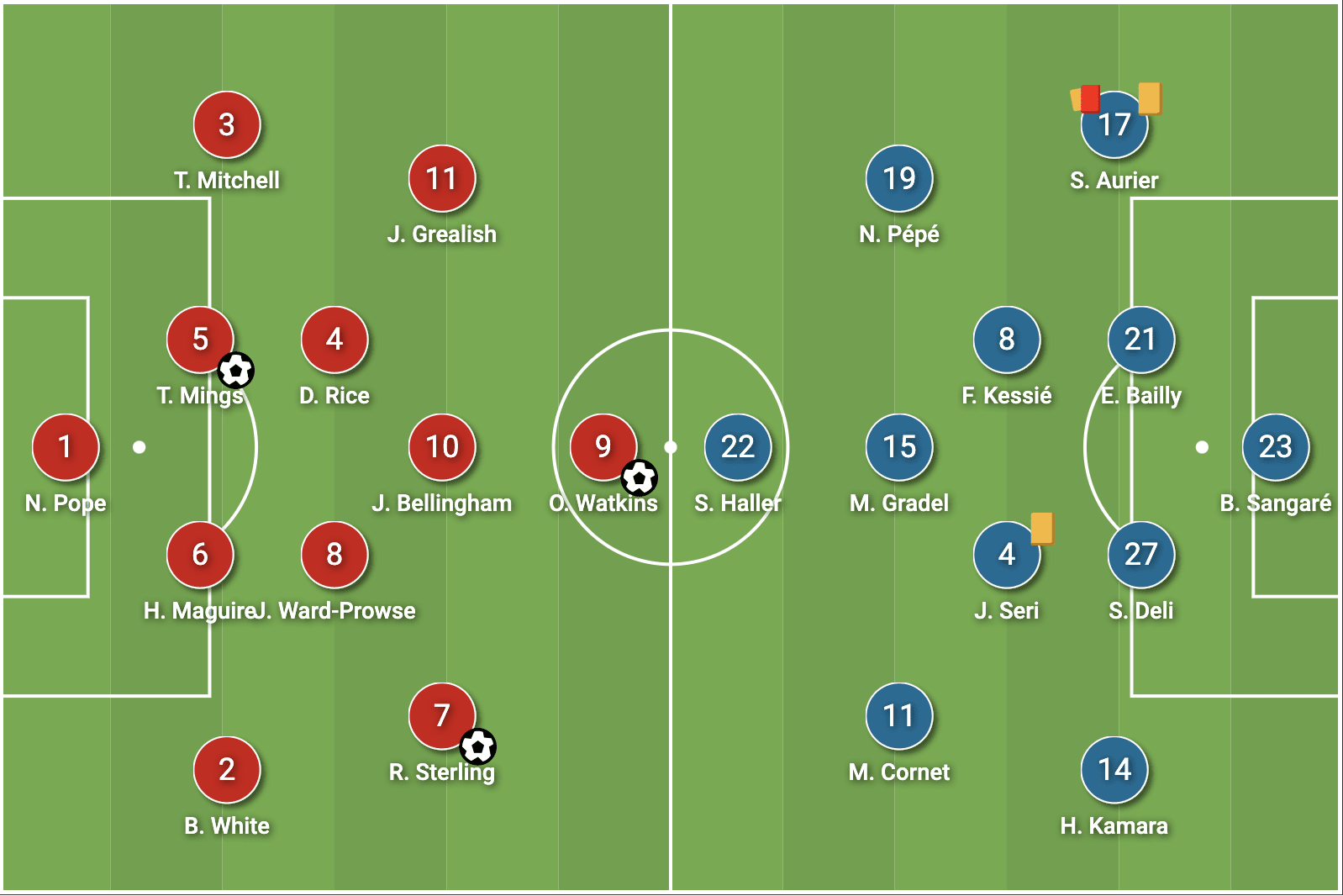
The Ivory Coast, fresh from a promising performance against World Champions France on Friday, lined up in a rigid 4-2-3-1 formation, with Premier League duo Nicolas Pépé and Maxwell Cornet flanking the in-form Sebastien Haller upfront. Franck Kessié and Jean Seri provided a protective double pivot behind Max-Alain Gradel, whilst Crystal Palace forward Wilfried Zaha missed out altogether through injury. The visitors pressed high and restricted the volume of ground passes in England’s build-up play as the opening quarter of the game struggled for pace and rhythm.
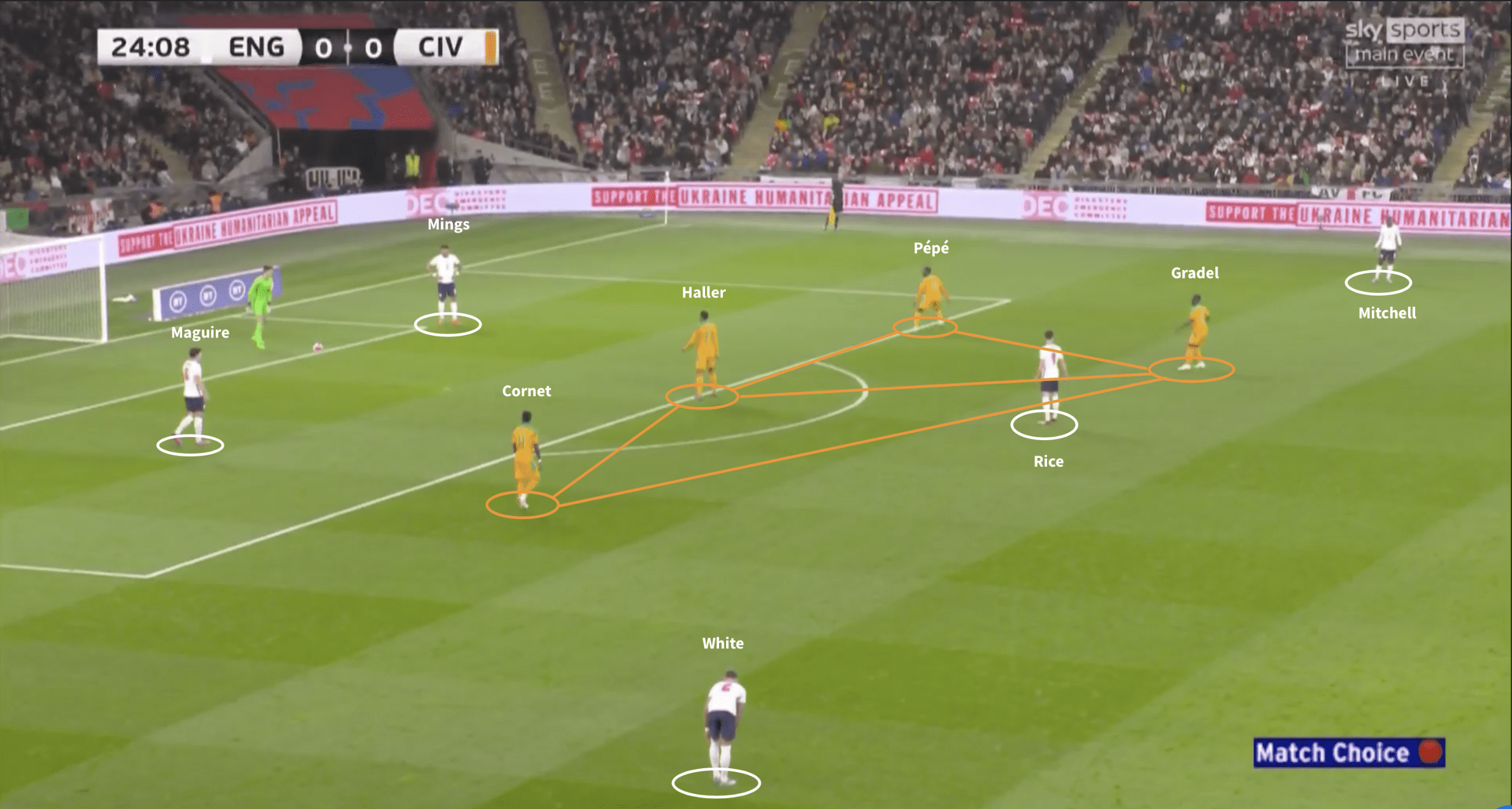
Here, the Ivory Coast deployed a high, compact block to overload England’s midfield pivot, which ensured that any ground passes to the centre-backs would immediately be met by a numerically superior line of pressure. Nick Pope was forced to go long on this occasion and England’s initial build-up play, whilst relatively untroubled, was not at its tidiest.
In a similar vein, the visitors championed ball retention across the backline but with little forward implications. England’s 4-4-2 mid-block out of possession allowed the centre-back duo of Eric Bailly and Simon Deli plenty of time on the ball, but any attempted vertical passes set the precedent for Rice to quickly engage and look to prosper from successful transitions.
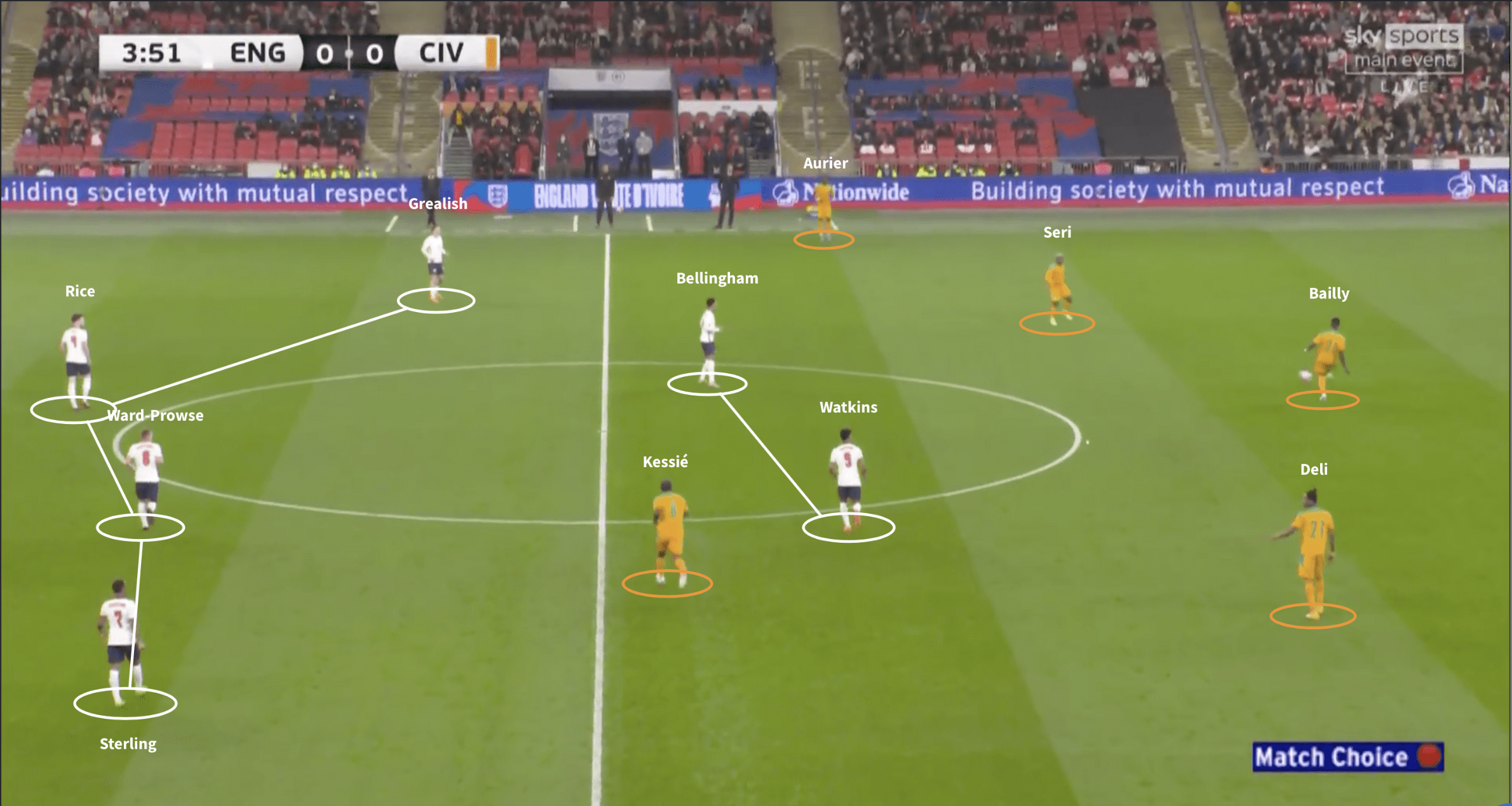
As exemplified above, Bellingham and Watkins would form an out-of-possession forward partnership, establishing a box (or a 2-2) with Rice and Ward-Prowse around the Ivory Coast pivot area. This forced Seri to continuously drop deep and receive possession to ensure numerical superiority in their build-up play.
Midfield rotations stretch visitors
In reality, England set up in a fluid 4-3-3 in possession; Ward-Prowse and Bellingham assumed wider and more advanced midfield positions either side of the deeper sitting Rice. This enabled Ward-Prowse and the excellent Sterling, once play had transcended the defensive third, to frequently rotate and fashion half-space crossing opportunities for the Southampton captain. This took advantage of the Ivory Coast’s high press and man-orientated marking system, particularly with Sterling, and made England’s attacking approach more mobile and unpredictable.
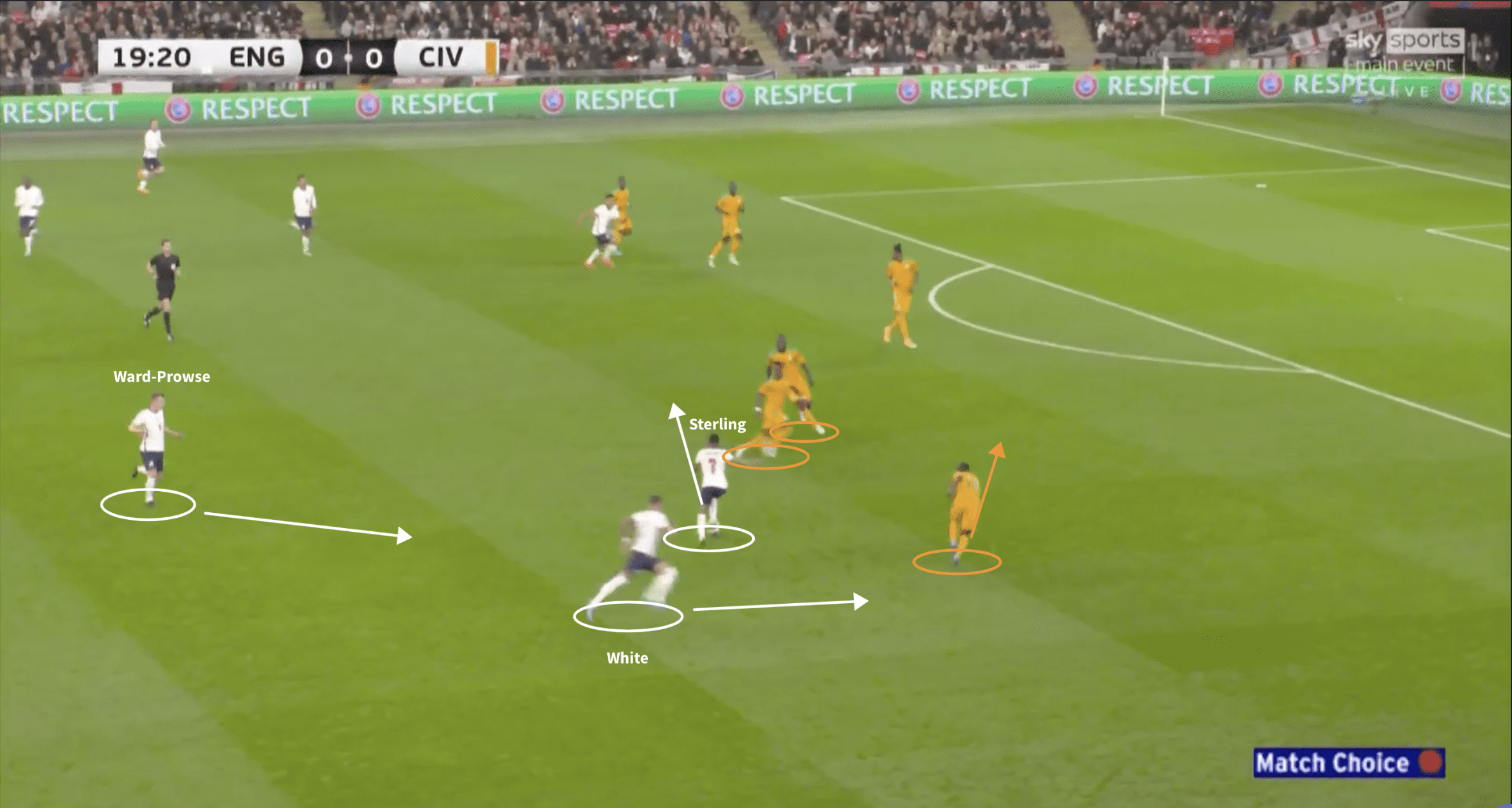
Here, the ball-carrier (Sterling) drives forward to attract engagement from the Ivory Coast double pivot of Seri and Kessié. Ben White makes a wide run to ensure the left-back (Kamara) is likewise pulled in deep and narrowly. This sets the precedent for Ward-Prowse to start drifting towards the right half-space.
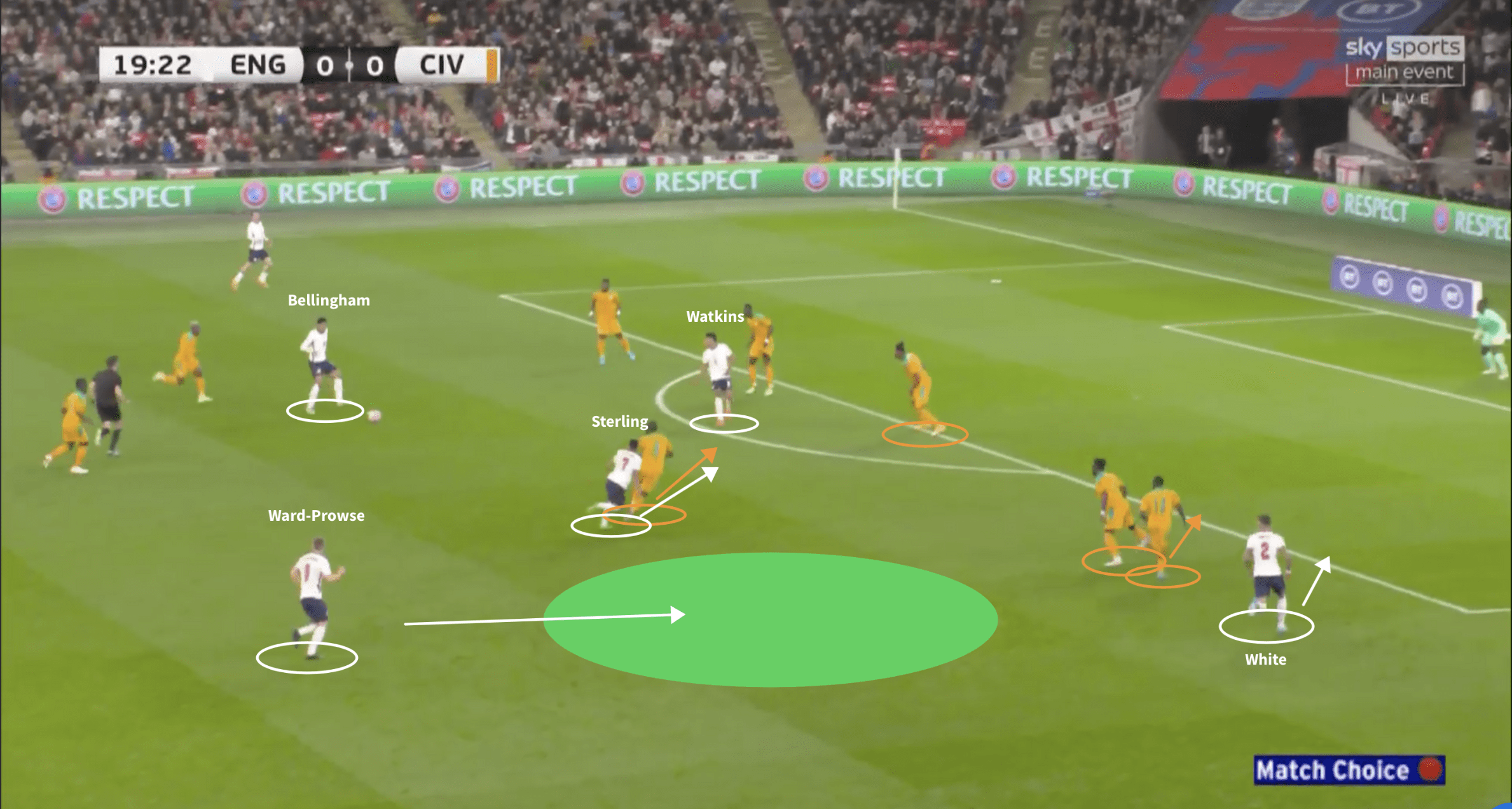
Sterling circulates possession to Bellingham and continues his run into the box, drawing his marker (Kessié) into a deeper position and fashioning half-space freedom for the dangerous Ward-Prowse to make a third-man run into and receive the following pass. Ben White’s aforementioned movement renders Kamara at left-back equally unable to close down Ward-Prowse, who is subsequently able to cross unopposed from a potent area and assist a shot on target.
By manipulating their wide structure, England here were able to identify a stronger method of facilitating progressive connections between their attacking players; effectively circulating the ball and engaging in purposeful off-ball movements until their main midfield playmaker was afforded time and space to pick a cross. It represented an effective means by way of shifting the opposition block and opening up the half-spaces for their more dangerous players to operate in.
Maguire makes his mark
England’s opening two goals came as a result of Sterling and Ward-Prowse again effectively rotating, but it was the role of Harry Maguire, reportedly subject to jeers from the England fans pre-match, which helped transcend the first line of pressure and help England establish an attacking scenario.
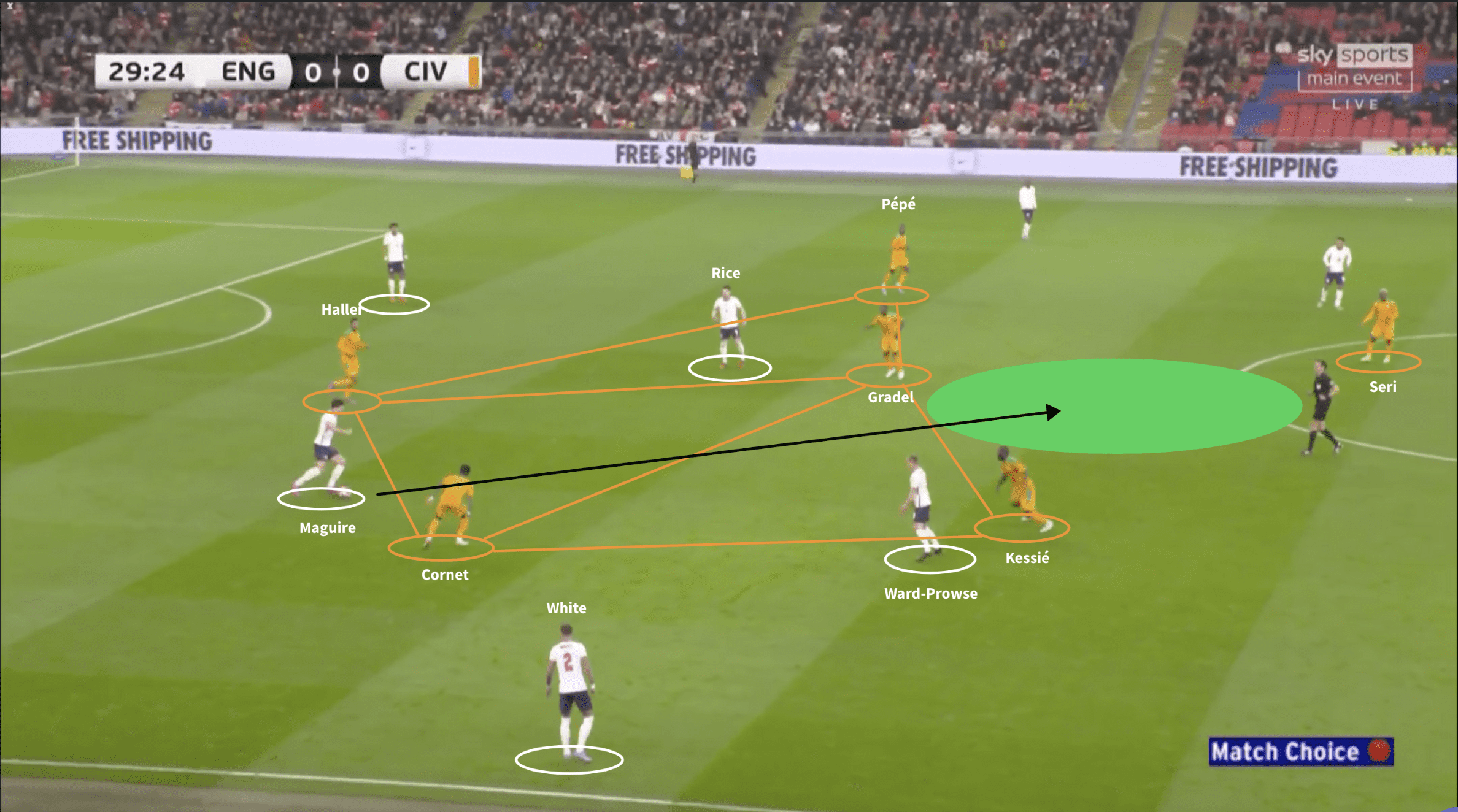
Here, Maguire, lining up in a somewhat unfamiliar RCB role to accommodate the left-footed Tyrone Mings, is met by a typically high yet uncoordinated Ivory Coast press. Haller and Cornet do not display enough lateral compactness, whilst Kessié is attracted to Ward-Prowse drifting horizontally, opening up vertical space for the Manchester United captain to drive into.
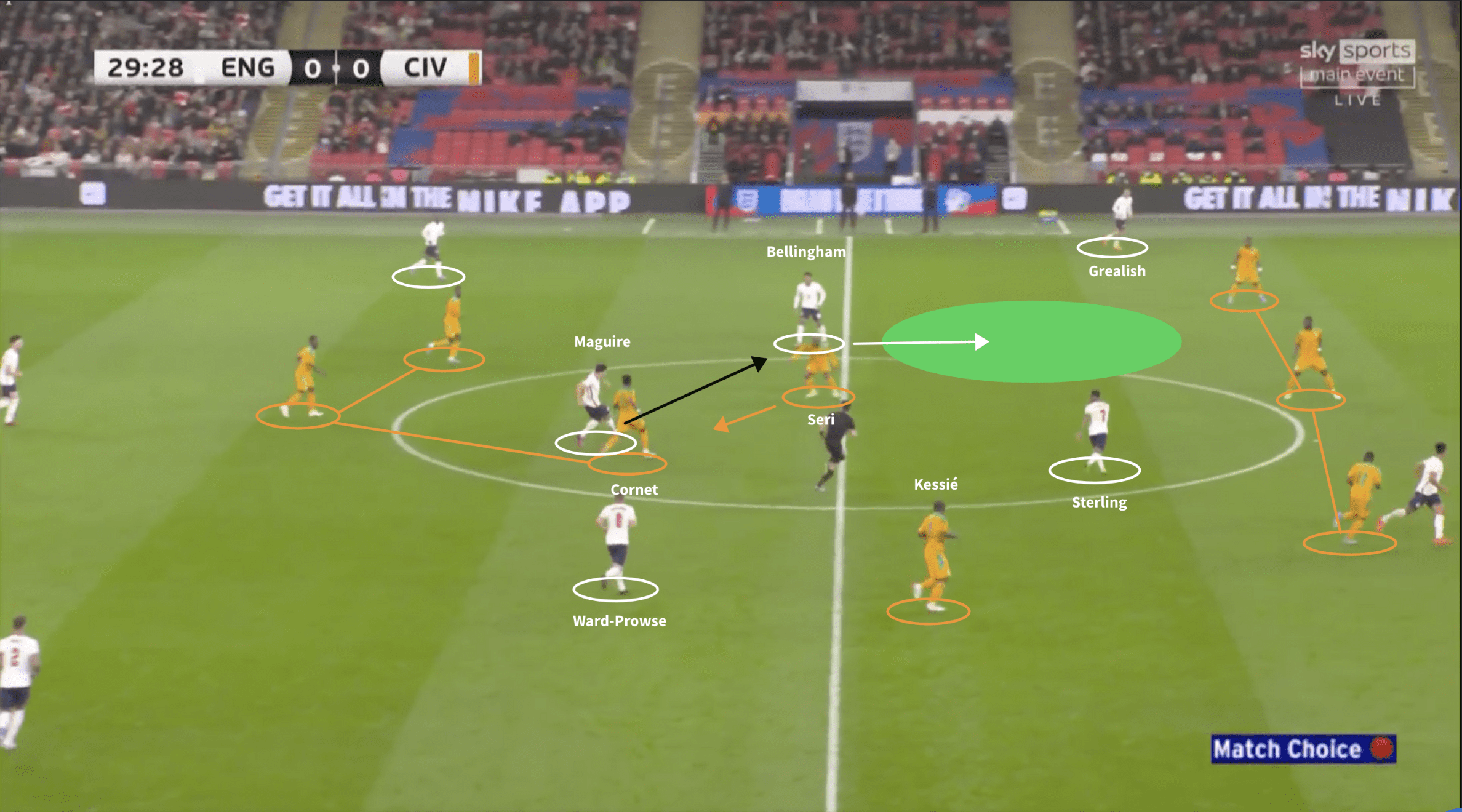
Maguire’s strength with progressive carries enables him to easily break the lines, and the visitor’s high-block is immediately compromised. Kessié’s wide positioning isolates Seri, now assuming a single midfield pivot role, who chooses to engage with Maguire and concede goal-side space for Bellingham in the left half-space. Also notice Sterling’s central positioning between the lines.
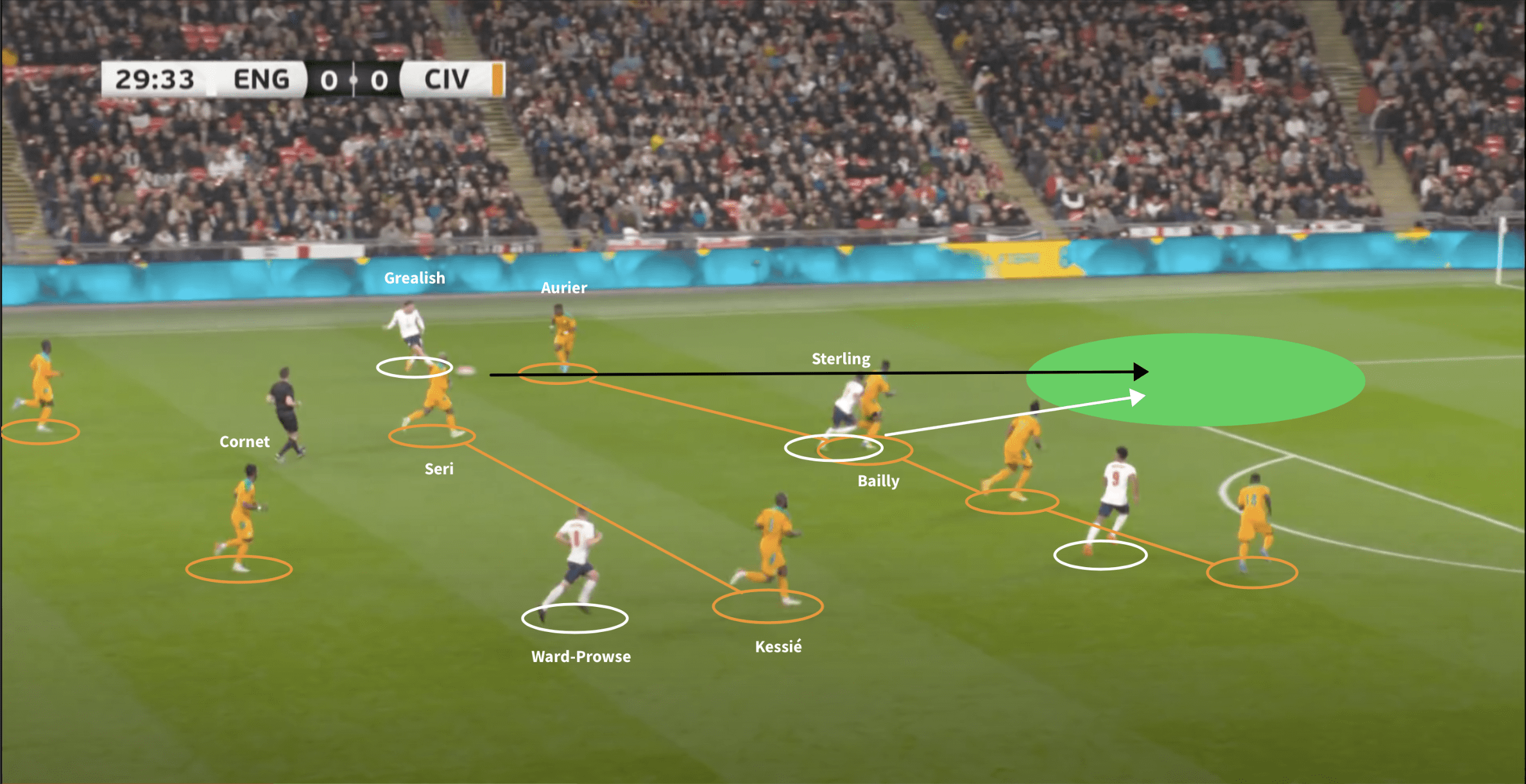
Bellingham works the ball onto Grealish, who spots the line-breaking run offered by Sterling; again profiting from finding himself in an advanced and central position as a consequence of his rotation with Ward-Prowse. A poor touch from Eric Bailly following an initial interception allows Sterling to win possession and beat his marker, expertly crossing for Watkins to tap the hosts into the lead.
Sterling’s positional freedom was again a catalyst for England fashioning the opportunity to progress the ball, but Maguire’s initial progressive carry that set the precedent for England to exploit the space after transcending the high press. Maguire moreover played a key role in the second goal; exhibiting his progressive passing ability to again break the lines.
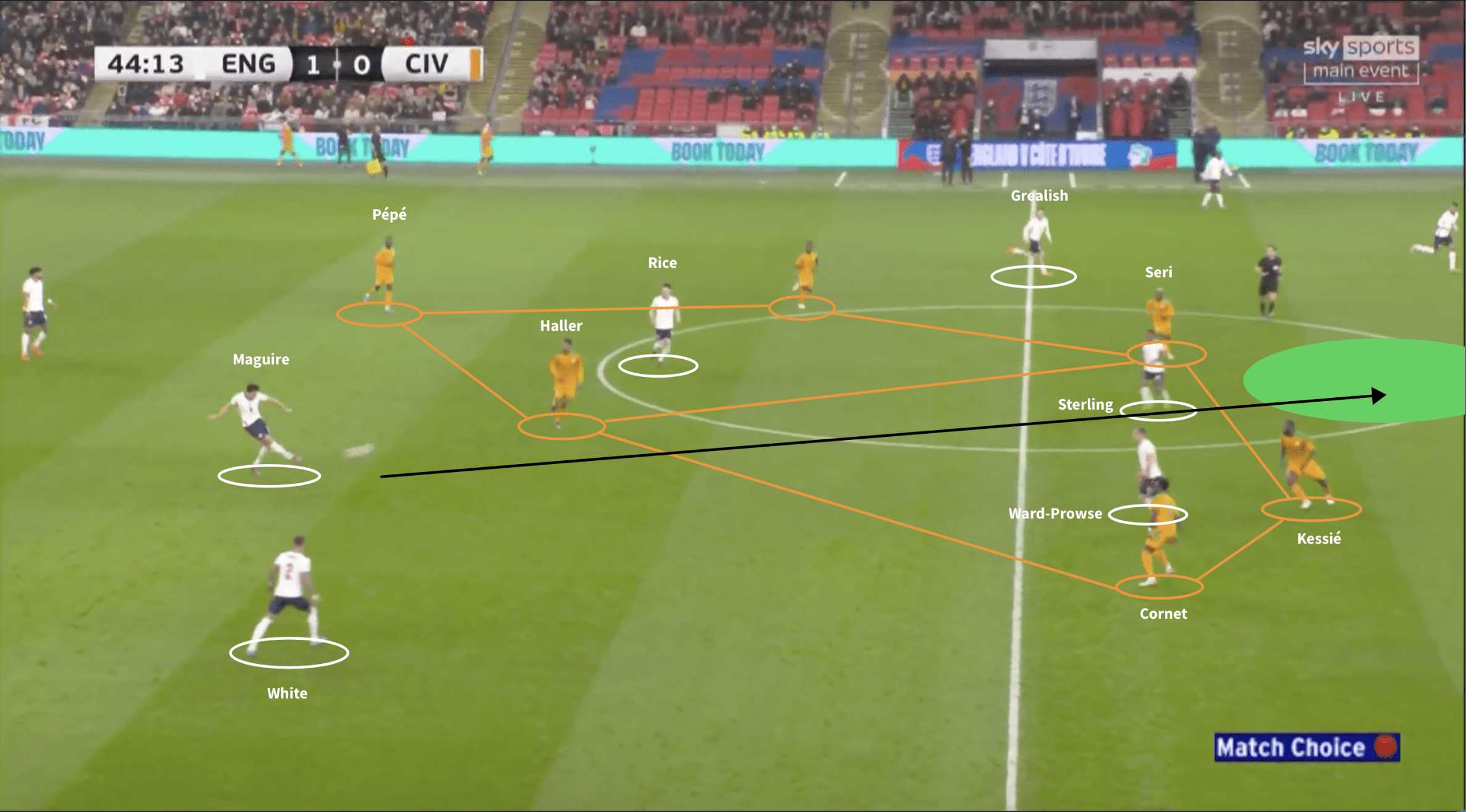
Maguire here receives possession in a seemingly innocuous position but is attentive to developments in front of him; Sterling and Ward-Prowse have once again rotated, with the former now in a position to receive the ball and vertically penetrate the Ivory Coast double-pivot. Maguire spots Watkins (out of frame) and drills the ball into the space between the lines, effectively taking six opposition players out of the game.
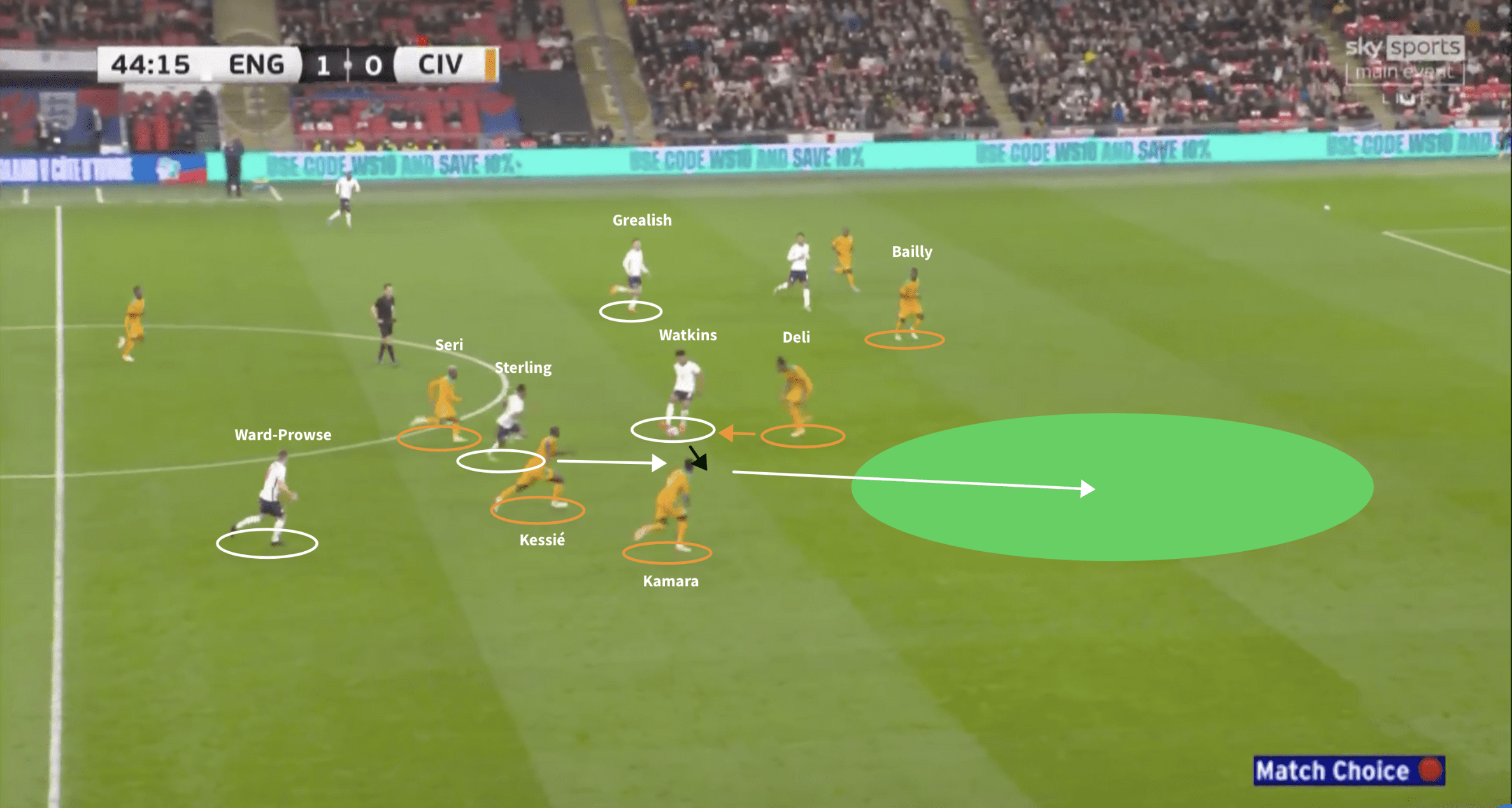
Watkins receives possession and draws engagement from Deli, fashioning space behind the center-back for the more dynamic Sterling to exploit. Watkins lays the ball off to Sterling, who penetrates the open space and, after seeing his initial effort saved, sweeps England into a two-goal advantage.
The ease with which England were here able to generate forward passing lanes and rotate accordingly so the more dynamic players could capitalise on the fashioned space demonstrates an impressive level of tactical cognisance and awareness. Maguire in particular exhibited alertness and technical excellence to single-handedly disconnect the lines of pressure, solidifying his role and importance to England’s build-up progression despite his poor domestic form.
Bellingham stakes his claim
England made a notable habit of overloading the ball side to achieve half-space superiority, which led to 18-year-old Jude Bellingham blossoming in an attacking midfield role on the left. The Borussia Dortmund starlet continued his fine domestic form at Wembley, drifting into pockets of space between the lines and establishing a strong progressive connection with Grealish on the left-hand side.
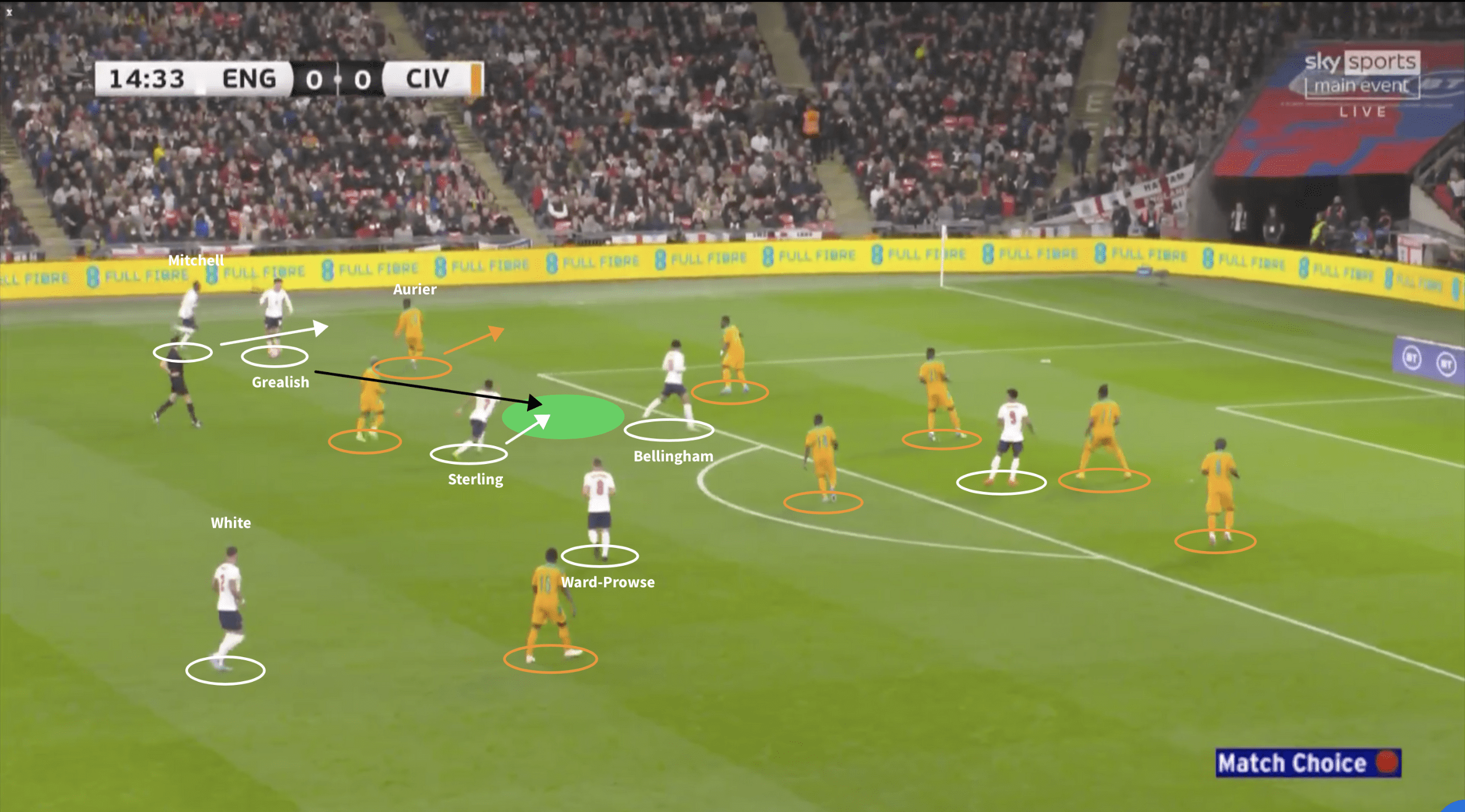
Here, Grealish receives possession and uses a wide decoy run from Mitchell to fashion space and pick a pass into the left half-space; an area England here achieved numerical superiority in as a result of Sterling’s blind-side run on Seri. The hosts now have two players in the same vertical channel and can exploit the provoked conditions in order to progress the ball and create a chance.
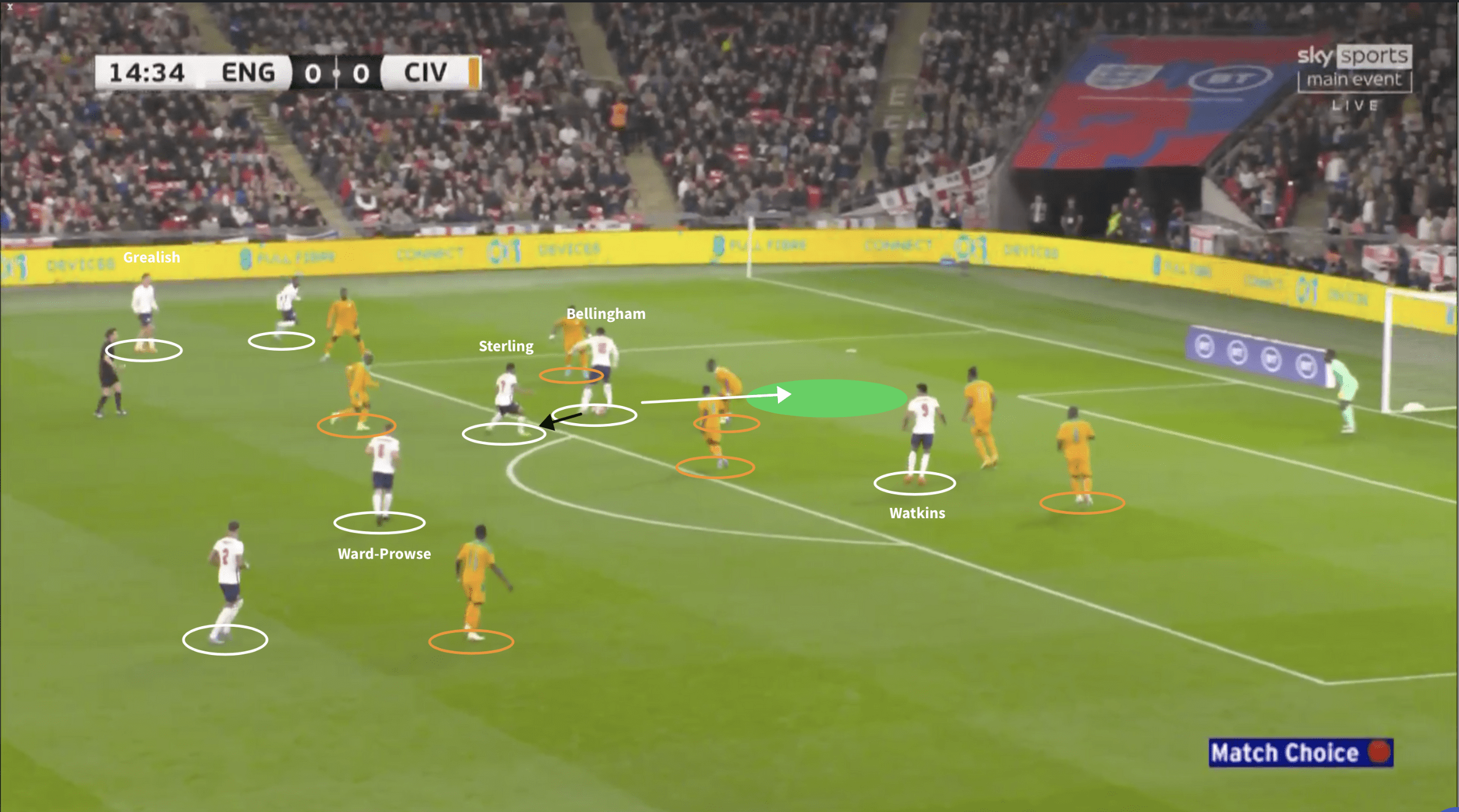
Bellingham displays his spatial awareness by flicking Grealish’s pass to Sterling and continuing his run into the penalty area. Sterling’s first-time return breaks the Ivory Coast line of defence and Bellingham hits the post, the hosts here generating a >0.35xG chance.
Bellingham completed 4 dribbles in the match, only bettered by Grealish, and was a constant threat down the left-hand side. His ability to develop connections with other attacking players gives him a very real chance of contributing for England when they line up in Qatar later in the year.
Bellingham even fulfilled a deeper role following a quadruple England substitution just after the hour-mark, assuming more responsibility in the build-up phase and commencing attacking patterns.
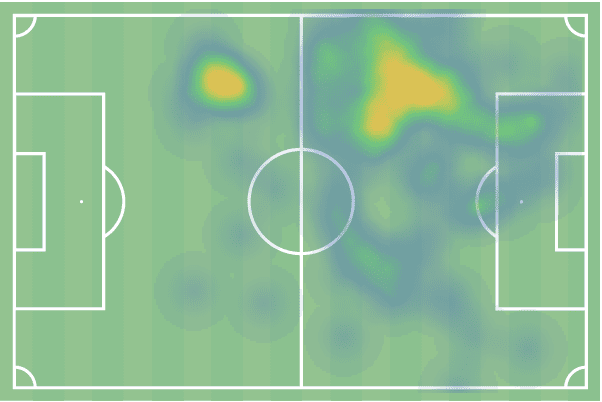
When considering England’s lack of depth in centre-midfield, with the likes of Jordan Henderson and Kalvin Phillips experiencing continuous injury plights and Mason Mount struggling to recapture his form from last season, Bellingham provides an alternative option and has arguably demonstrated a superior ability than some of his teammates to progressively link attacks and establish connections in offensive passages. The question now really isn’t about whether Bellingham should make the England squad; it is about whether he should start altogether.
Conclusion
England provided a promising display of their diverse attacking possibilities; this tactical analysis conveyed their ability to rotate in possession and establish the best progressive connections to generate chances and create space for crossing specialists to operate in. England’s ground-passing during the build-up phase was not at its most fluid, but they overcame this by utilising Maguire’s strong progressive carrying and passing ability to transcend the first line of high Ivory Coast pressure.
The personnel tweaks also represent selection dilemmas for Gareth Southgate; would the likes of Kalvin Phillips pose as much half-space threat as Ward-Prowse? Would Mason Mount be able to cast away his underwhelming domestic form and deliver as much creative threat as Bellingham? The sample size for these assertions is of course small, but it is a healthy issue for manager Southgate to ponder as England again attempt to win their first international tournament for 56 years.





Comments